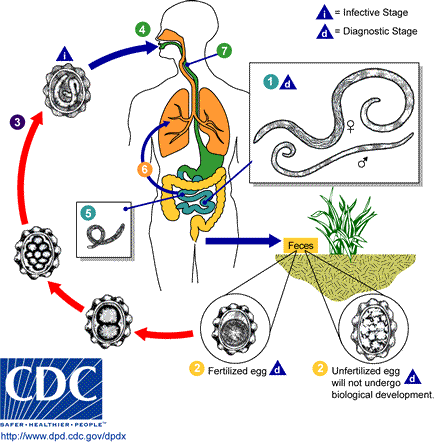From Wikipedia, the free encyclopedia
 |
This is a file from the Wikimedia Commons. The description on its description page there is shown below.Commons is a freely licensed media file repository. You can help.
|
| Description |
Adult worms 1 live in the lumen of the small intestine. A female may produce approximately 200,000 eggs per day, which are passed with the feces 2. Unfertilized eggs may be ingested but are not infective. Fertile eggs embryonate and become infective after 18 days to several weeks 3, depending on the environmental conditions (optimum: moist, warm, shaded soil). After infective eggs are swallowed 4, the larvae hatch 5, invade the intestinal mucosa, and are carried via the portal, then systemic circulation to the lungs . The larvae mature further in the lungs 6 (10 to 14 days), penetrate the alveolar walls, ascend the bronchial tree to the throat, and are swallowed 7. Upon reaching the small intestine, they develop into adult worms 8. Between 2 and 3 months are required from ingestion of the infective eggs to oviposition by the adult female. Adult worms can live 1 to 2 years. From http://www.dpd.cdc.gov/dpdx/HTML/ImageLibrary/Ascariasis_il.asp?body=A-F/Ascariasis/body_Ascariasis_il11.htm |
| Source |
Originally from en.wikipedia; description page is/was here. |
| Date |
2005-04-06 (original upload date) |
| Author |
Original uploader was Tagishsimon at en.wikipedia |
Permission
( Reusing this image) |
PD-USGOV-HHS-CDC.
|
License information
 |
This image is a work of the Centers for Disease Control and Prevention, part of the United States Department of Health and Human Services, taken or made during the course of an employee's official duties. As a work of the U.S. federal government, the image is in the public domain. |
|
Original upload log
(All user names refer to en.wikipedia)
- 2005-04-06 16:36 Tagishsimon 435×443×7 (30680 bytes) Adult worms 1 live in the lumen of the small intestine. A female may produce approximately 200,000 eggs per day, which are passed with the feces 2. Unfertilized eggs may be ingested but are not infective. Fertile eggs embryonate and become infective af
File history
Click on a date/time to view the file as it appeared at that time.
|
|
Date/Time |
Dimensions |
User |
Comment |
| current |
21:15, 12 November 2006 |
435×443 (30 KB) |
The cat |
|
File links
The following pages on Schools Wikipedia link to this image (list may be incomplete):

